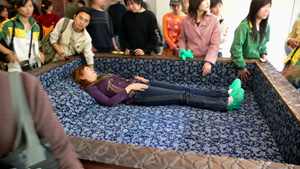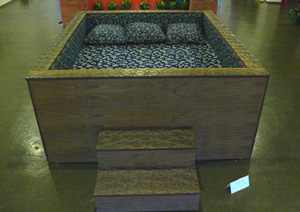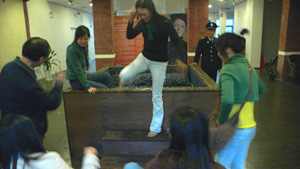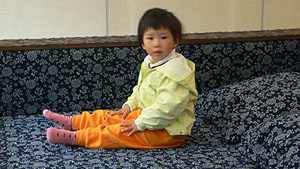Dear Kaffe,
This is Aimee Lin from City Pictorial, a Chinese magazine in Chinese lanuage, asking for a simple interview via email on the sound-bed project in Shanghai.
We find the sound-bed displayed in the museum very interesting, so here I have some questions and hope you are kind enough to answer them : –
Q1: From when have you been thinking of the idea of “sound-bed” and how did the idea come into you mind?
KM: I’ve long been interested in the physical experience of music, enjoying music as vibration, as something you feel as well as listen to through your ears, and between 1997 and 2000 I made 2 sonic armchairs that played specially composed pieces to be able to explore these ideas. See Works section
These chairs, with 9 to 12 speakers immersed under their upholstery, created situations that transform the listening experience for the sitter, turning ‘weird’ or ‘boring’ music into something meaningful. All kinds of people would queue for hours to have a “ride” in the chair, would have a completely different experience to what they might expect, love it and talk of the musical as well as physical and psychological experiences they had had afterwards.
The fact that suddenly new, maybe strange to many, experimental electronic music was now accessible to a widely varied audience was a hugely important discovery and became a central foundation to my ongoing work in Sonic Furniture and current Music for Bodies Project..
For the past 10 years, the body of my work has been improvised site specific performances through quadraphonic(4 channel) sound systems, which are about my working live with an open bag of unknown sound ingredients that have to be dealt with moment by moment in front of an audience. Sonic furniture provides quite the opposite: a purposefully constructed, intimately known, containable, portable venue, for which a specific piece is carefully made and which audience can then experience together or alone, feeling it directly through their bodies, not just their ears. The compositions made then are absolutely based around the mapping of specific sounds (frequencies) to specific areas of the body and then the movement and transformation of these sounds inbetween. This means that making music for multichannelled Sonic Furniture requires new compositional techniques and so possibilities for new music making and discoveries.
The making of a Sonic Bed after making Sonic Chairs then also allowed a big step in this enquiry and in several directions. Initially, it is the first opportunity to work with a visitor lying down to experience the music, secondly, that a bed is a potentially social space (will you lie next to a stranger? ). Third, that the space under the bed’s mattress provides much larger spaces for speakers than a chair, enabling the use of sub-woofa speakers and bass frequencies and so types and levels of vibration not yet managed through the chairs.
Q2: The idea of sound-bed reminds me of the French musician Erik Satie who said he would like to deal with “music” as furniture in the room. How do you think of Satie’s idea? Is there anything in common in your work (or theory) and Satie’s? Anything different?
KM :Satie’s idea was a fabulous and pretty radical idea for its time. However, you making this comparison makes me wonder if you have ever actually lain in the bed?! If not, please go and lie in it now and you will understand what I say here, (this goes for any reader by the way too……..) !
For the central idea behind Sonic Bed is pretty much the antithesis of Erik Satie’s Furniture music. Satie was inviting people not to sit and listen to his music, or watch it being performed, but just to let it play and exist in a room much like a piece of furniture would. Hence this ‘furniture music’ term he coined. Kaffe Matthews Sonic Furniture and in this case her Sonic Bed, invites you not to do this at all, but instead to go and directly interact with the music as it emerges from the speakers. To go and literally lie in the music. To feel it moving up and down and around your body, and listen to it that way. Certainly yes, you will hear the Sonic Bed’s music by simply entering the gallery where it is currently exhibited, but you will not experience it or understand what the music is really doing, or what it was made for, until you actually get in it.
Q3: On the sound-bed in Shanghai — where did you get all the sound elements from the city and how did you deal with them so that you could finally present them like the sound-bed did?
KM: The sound work playing in Sonic Bed_Shanghai was made using sounds recorded in and around the Bund and the Wuangpu river during field visits in December and February 2005-2006. I made the piece by focusing mainly on the river movement and boat horn sounds from my recordings, improvising and processing them through the sound system in my Sonic Bed_London. I then constructed the piece using the specially designed software instrument built in collaboration by David Muth, and remixed the whole thing in Sonic Bed_Shanghai once in the gallery. It was interesting. Sonic Bed_Shanghai feels a very different space to compose for than Sonic Bed_London, largely to do with the different feel it has due to its sound system, the flower carving and patterned upholstery, and I found that several aspects that worked in the London version just were not right for the Shanghai one.
Q4: We notice that you were recording with dv during the opening, so how do you think of people’s reaction to your work?
I was delighted that people were so interested, but I am now hoping that without so much media and press present, visitors will not be so shy about getting into the bed. Sonic Bed_Shanghai is about feeling the music that it plays, not just looking at and listening to. Do, go and get in it !
KM May 2006.





